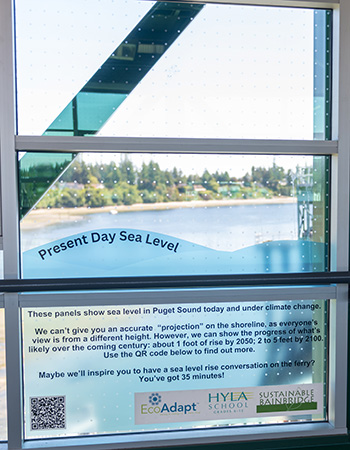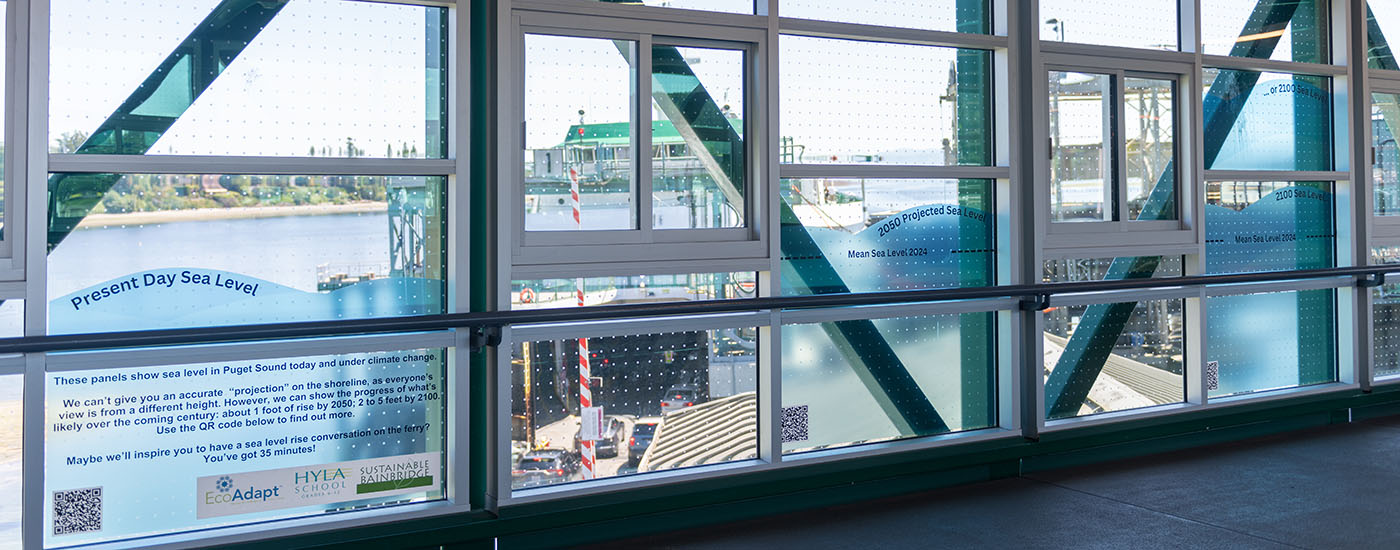“Tens of thousands, maybe hundreds of thousands, of people will walk by this infographic and potentially learn about sea level rise.”
Rising seas. Record-breaking heatwaves. Vanishing species. It’s easy to feel overwhelmed by the constant stream of climate news. But while the challenges are real, giving in to despair isn’t the end of the story. The most powerful antidote to climate anxiety isn’t retreat — it's action.
Just ask James Rufo Hill.
At Hyla School on Bainbridge Island, James teaches Global Warming: Understanding the Issues, a University of Washington course (Atmospheric Sciences 111) offered through the UW in the High School program that’s turning concern into creativity. His students aren’t just learning about climate change; they’re doing something about it.
Thanks to a unique partnership with Washington State Ferries, EcoAdapt, Sustainable Bainbridge and other local organizations, the students at Hyla designed interactive ferry terminal signage to educate daily passengers about rising sea levels.

The infographic's QR code leads to a powerful student-built site that brings data and the urgency to life.
More than a class project, the initiative is a community-wide conversation starter and a powerful reminder that meaningful change starts with informed individuals. And that sometimes, the first step toward a better future is as simple as catching the ferry and seeing the signs.
“It’s an incredibly visible, far-reaching project,” says James. “Tens of thousands, maybe hundreds of thousands, of people will walk by this infographic and potentially learn about sea level rise.”
A Career Rooted in Climate Action
With a bachelor’s in atmospheric science and a master’s in urban planning, James spent more than a decade helping the City of Seattle prepare for the realities of climate change. He focused on urban flooding, water resources and sea level rise, collaborating with Seattle Public Utilities, the UW and agencies across the country to bring climate science into real-world planning.
But something unexpected happened along the way. A few times a year, James would visit local classrooms to talk about the weather. He found himself loving the experience. So much so that he went back to school, earned a teaching degree and made a career pivot.
“Now, I’m in my fifth year of teaching science. It’s exciting because I’m getting to teach something that I have been working on my whole life,” James says. “I enjoy connecting with kids and want to inspire youthful climate actions.”
That spark is exactly what organizations like EcoAdapt, a world-renowned nonprofit that focuses on climate change adaptations, are eager to ignite in the next generation. So, when WSF reached out to EcoAdapt for help educating ferry passengers about sea level rise at the Bainbridge terminal, their connection to James made turning to his class for support a natural choice.
“When you tell your professional network you’ve become a teacher, suddenly everyone wants access to the youth,” James laughs. “It’s like, ‘Oh my gosh, can they do a project for me?’”
This time, the timing couldn’t have been better. Hyla School had just introduced UWHS, adding UW courses in math and atmospheric science (and expanding to include Spanish, global health and astronomy later) and opening new doors for students eager to take on college-level challenges without AP classes.
As part of this new program, James’ course is also taught on the UW campus and lets the students earn college credits. And since the curriculum requires students to complete a community-based project, the partnership was a perfect fit.
Engaging the Classroom With the Community
For senior Carson Cramer, the project provided an opportunity to connect atmospheric science with a relevant global issue.
“I enjoyed taking this big idea of climate change and seeing the different strands of learning that trickle down to the basic concepts,” Carson says. “I also appreciated the course because I like taking advanced science classes, and it was nice to prepare for college-level work.”
Working alongside WSF’s chief sustainability officer, Kevin Bartoy, EcoAdapt and local design firm Graffix, the students developed an eye-catching infographic for the ferry terminal’s passenger walkway. Positioned at the start of the ferry queue, the display offers a striking visualization of sea level rise with the intent of sparking curiosity and conversation.

“We wanted people to have an immediate picture that this is going to happen,” explains Carson. “That’s the message: it is going to happen. It’s just a matter of when and what we do about it.”
To deepen the impact, the students added a QR code linking to a website they built themselves. Grounded in the science they studied, the site breaks down the facts and causes behind sea level rise, explaining that by 2100, Puget Sound will be 2- to 5-feet higher than it is today. An interactive map allows users to toggle through the years and watch the flood lines shift. It’s a powerful, tangible way to grasp what five feet of sea level rise means for the region’s shorelines and the actions communities can take to prevent further damage.
A Ripple Effect Across the State
James is proud of what his students accomplished. Not just because the project turned out to be a terrific way to fulfill the requirements of the course, but also because it’s reaching far beyond the classroom.
The success of the Bainbridge terminal project has inspired a wave of momentum. Knowing that rising sea levels will impact their service, WSF is replicating the project at the Kingston terminal and potentially across all ferry terminals in the state to help spread climate change awareness.
James credits the UWHS program for providing Hyla students with a meaningful academic challenge. “With its higher standards, UWHS raises the bar for education at the whole school,” he says. “It gives the kids something to strive for and a window into the next level.”
But what excites him most is the long-term impact.
“This course is good because students learn the details and mechanics of the science and policy,” James explains. “That way, when they move on to college, and even beyond, and find themselves in a place where some kind of momentum is occurring, they'll be able to jump in and be a positive, constructive member.”
